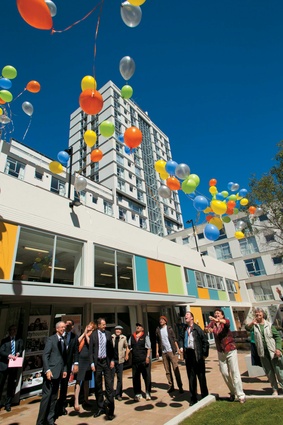On shaky ground
Is the focus on protecting loss of life detrimental to the long-term resilience of New Zealand's commercial building stock?
For the construction industry, the marked shift towards a focus on seismic issues, combined with the last few years of a significantly deflated market due to the recessionary period has resulted in a lack of new builds and a spike in retrofitting seismic solutions and strengthening work. This is being driven by both the needs of tenants and building owners, and is rooted in a swift but deep-set change of attitudes towards building safety following the Canterbury earthquakes. The more recent significant earthquakes in the Wellington region provided a renewed warning about the seismic resilience of the country’s commercial building stock.
For tenants, the seismic problem is primarily a matter of fusing their obligations under the Health and Safety in Employment Act (1992), with the seismic standard of building they are morally happy for their employees to occupy. That is not to say economic realities including heavily increased insurance premiums don’t have their part in driving tenants’ motivations, particularly if they are occupying a building that does not meet the minimum standard of 34 per cent of the new building standard (%NBS) and is therefore deemed earthquake-prone.
For building owners, the seismic dilemma pivots on the economic reality of wholly funding what can be expensive and disruptive strengthening work with no increase in the value of their asset as a result of the potentially significant output. If a building is deemed earthquake-prone, the risks of not investing in seismic strengthening are wide-ranging, and potentially include an inability to insure the building, an inability to attract and retain tenants, and an inability to secure ongoing finance.

Currently, building owners are bound by the regulations of the local authority in which their building/s are located. However, the government’s recently announced policy change provides a more regimented, national approach to the issue, requiring territorial authorities to assess all buildings of a certain type (non-residential and residential multi-unit and multi-storey) within five years, and for building owners to then either strengthen or demolish if necessary within a further 15 years. While there are exceptions for Category 1 heritage listed buildings – a further 10 years to strengthen – and exemptions for buildings where the impact of failure is low, such as farm outbuildings and some rural halls and churches, for most
the timeframes will be stringent. It is expected legislation to amend the Building Act (2004) will be put before parliament later this year, until which time building owners will be required to continue adhering to the regulations of territorial authorities.
While the new policy provides clarity in relation to timeframes, the minimum requirement for strengthening remains the same and building owners will be required to bring an earthquake-prone building up to 34%NBS as is currently the case. While this is aimed at protecting loss of life in a seismic event, critics believe working only towards a %NBS is short-sighted and does not account for the long-term sustainability and resilience of our commercial building stock.
New Zealand Society for Earthquake Engineering (NZSEE) executive officer Win Clark is urging building owners to strengthen to double the minimum requirement. “The public needs to be made widely aware that the Building Code is about life safety. While a building strengthened to 34 per cent of the standard might be legal, it does not mean that it will not be significantly damaged in an earthquake,” Mr Clark said. “We understand that building owners are concerned about costs but it is worth the extra effort now to put significantly increased resilience into your building,” Mr Clark said. “The greater resistance to earthquakes will improve an owner’s ability to obtain insurance and attract tenants.”
Miyamoto Impact chief executive officer David Weir said the country’s sustained focus on attaining a certain percentage of new building standard was concerning. “The problem we have now is that by being focused purely on a percentage of the NBS, it is driving the rental market and we have tenants moving in and out of buildings based purely on this percentage,” Mr Weir said. “What needs to be highlighted, and what building owners and tenants need to be aware of is that working towards, for example, strengthening a building to 100%NBS does not create a resilient building.
“What we have seen in Christchurch is, in reality, buildings that for all intensive purposes performed relatively well. Only two buildings fully collapsed. Those buildings that didn’t fall down met the intent of the Building Code, which is primarily about life safety. A building that is built to 100%NBS is a building that is designed for life safety and is not necessarily a resilient building. More than 1,500 buildings in Christchurch CBD have since been demolished, although those buildings did perform to the purpose for which they were designed. Resilience needs to be considered in new builds, and in strengthening. There are numerous techniques that can be used to retrofit, or in new builds.”
St Andrew’s Church, a 1922 heritage-listed building, was strengthened by Ebert Construction (architect - Opus Architecture, structural engineer - Opus International)
Miyamoto Impact bases their work around resilience, as opposed to the %NBS, focusing on the central structural weaknesses of a building and then looks at options to provide solutions for those aspects. “That is not to say, at the end of it, the building doesn’t come out with a %NBS rating. It does, but the focus is not on that percentage alone, it is on resilience, and buildings that can withstand multiple earthquakes.”
As part of its 2012 review, MBIE highlighted the risk of fatality from an earthquake in New Zealand; a figure deemed to be approximately one in 1 million. Altogether, 483 people are recorded as having died in earthquakes in New Zealand since 1843, while 37,000 people have died in road accidents, with 1,125 fatalities in the three-year period from 2008 to 2010.
However, recent findings by Jones Lang LaSalle highlighted the increased perception of risk about seismic safety. It found Wellington office space was valued on average at $300 per square metre for 100%NBS, while space assessed at less than 33%NBS was priced at $160 per square metre. The survey also found 78 per cent of tenants wanted to occupy a building with a rating higher than 67%NBS.

Wellington-based architect Richard Chung, principal of Wareham Cameron + Co, said the market in the capital was currently characterised by a lack of new office builds, with the new builds of yesterday becoming the major refurbishment and strengthening jobs of today. “After the Christchurch earthquakes there was a wider awareness of how catastrophic seismic events can be,” Mr Chung said. “But perceptions have become reality. If people perceive they have to be in safer buildings even though the risk hasn’t changed, then that acts as a driver for the market as a whole, which is what we are seeing in Wellington at the moment with a sustained focus on strengthening and a lack of new builds.”
The NZSEE is calling on building owners to have buildings assessed and strengthened as soon as possible, despite the relatively long timeframes that will be imposed nationally. “It is essential that landlords become proactive rather than reactive with regard to the significant risks to life posed by earthquake prone buildings. They need to be strengthening their buildings before an earthquake happens, rather than after. Ultimately the decisions of commercial landlords will be driven by demand. Tenants should be asking their landlords these questions and have an expectation that the buildings they live and work in have been strengthened in a timely fashion, to best practice standards. And best practice is 67 per cent of the current building standard or higher,” Mr Clark said. “If we have another major seismic event in a metropolitan centre like Christchurch, that could just about break this country financially. We need to increase the resilience of buildings so we can economically withstand the shock of another seismic event,” he said.
Commercial property law specialist Paul Calder, of Christchurch firm Duncan Cotterill said once the Royal Commission enquiry got underway attitudes changed overnight. “Thirty four per cent of the current Building Code became the criteria to occupy a building. Anything less than 34%NBS tenants were reluctant to let their staff occupy,” Mr Calder said. “There is a balance between wanting to take appropriate account of the risks, and meeting the economic aspects of earthquake strengthening. The existing legal framework does not deal with a change in attitudes, which is what has happened since the Christchurch earthquakes.”
Mr Calder said the most common issues arising were based on a tenant deciding they were no longer happy to occupy a building. “The tenant is contracted to lease a building. If that building hasn’t deteriorated or if there has been no damage to it, if for example it is 10%NBS, but that is as a result of the design and age of the building, then the tenant doesn’t have a right in most leases to say: ‘Right, this building is no longer safe to occupy.’”
Mr Weir said until now building owners had been waiting for confirmation around national requirements for strengthening before committing to any upgrades, but there were also other issues building owners should consider before embarking on a schedule of work. “The other real concern for building owners is that the code changes regularly, normally every five or 10 years, so that needs to be taken into account if strengthening only to the current minimum standard, which is likely to be changed again.”












